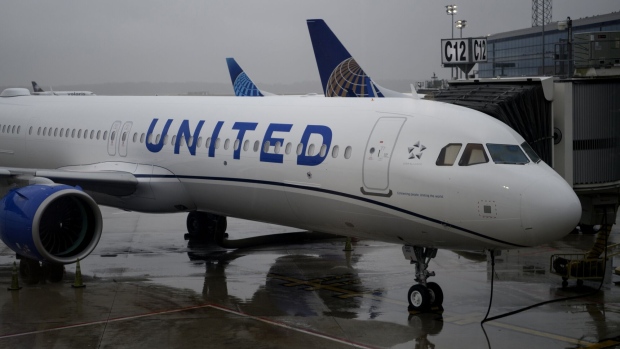Mar 8, 2024
United Plane Veers Off Runway in Third Boeing Incident This Week
, Bloomberg News

(Bloomberg) -- A United Airlines Holdings Inc. aircraft ran off the taxiway into a grassy area after landing at Houston on Friday, marking the third headline-grabbing incident this week involving the carrier’s Boeing Co. planes.
United Flight 2477, with 160 passengers and six crew, had just landed at George Bush Intercontinental Airport about 8 a.m. local time when it veered into the grass on a turn. No one was injured, and passengers left the 737 Max on a set of mobile stairs before being bused to the terminal, the airline said.
Friday’s incident involves a 737 Max built four years ago that has been in service for less than a year. It follows the mid-air loss of a tire from a United Boeing 777-200 Thursday, just after the plane took off from San Francisco on a flight to Osaka, Japan, and an engine failure on a United flight from Houston to Fort Myers, Florida, earlier this week.
The plane in the Houston-to-Florida flight had to make an emergency landing after one of its engines began belching flames 10 minutes after takeoff. The engine ingested plastic bubble wrap that had been left on the airfield prior to departure, according to United.
The 21-year-old aircraft was also a 737 — but an earlier version than the Max, according to FlightRadar24.
United will investigate each incident “to understand what happened and learn from them,” the carrier said in a statement Friday. “Each of these events is distinct and unrelated to one another.”
Boeing shares fell 2.2% at the close on Friday, continuing the worst drop this year among members of the Dow Jones Industrial Average. United slipped 1.9%.
The 777 headed to Osaka had 249 people on board. It diverted to Los Angeles International Airport and landed without incident. The tire that plummeted damaged at least one car in an airport parking lot.
Read more: Tire Falls From United Airlines Plane, Hits San Francisco Cars
The Federal Aviation Administration said it will investigate all three incidents, while the National Transportation Safety Board is sending a team to Houston. United said it will work with the FAA, NTSB and Boeing to understand what happened. While they came in rapid succession, this week’s scares don’t appear linked to known issues with Boeing and its 737 Max, and are unlikely to signal broader safety trends.
In addition to the three incidents, at least two other issues involving United and Boeing occurred this week. On Monday, a United flight en route to San Francisco from Honolulu encountered an engine failure over the Pacific before landing safely at its destination, the San Francisco Chronicle reported. That plane was a Boeing 757-300. The FAA also said it’s investigating a United flight from Pensacola, Florida, which landed safely Monday in Chicago after reporting a gear issue with the 737 aircraft.
On Friday evening, United Flight 821, this time an Airbus 320, was diverted to Los Angeles while traveling from San Francisco to Mexico City. Preliminary investigations showed an issue with one of the three hydraulic systems on board the plane, and all 105 passengers deplaned normally, the carrier said. Customers were to travel to Mexico on a new aircraft, United added.
737 Max
The mishaps come at an inopportune time for Boeing. The planemaker is working to restore its reputation following a midair panel blowout on an Alaska Airlines flight earlier this year. The NTSB has found that Boeing workers apparently didn’t attach four bolts holding the panel to the plane’s fuselage.
The plane in the January incident was also a 737 Max. Boeing has come under withering scrutiny from regulators, lawmakers and customers over manufacturing quality on the model, which re-entered the headlines this year after its global grounding in 2019 following two fatal accidents.
Among Boeing’s harshest critics has been United Chief Executive Officer Scott Kirby. United has taken the coming 737 Max 10 out of its planning. The airline is considering switching to other variants of the Max and is in talks with Boeing rival Airbus SE on alternative aircraft that could replace some of its massive Max 10 order.
In a separate action related to the 737 Max, the FAA on Friday said the plane had wiring issues that were prompting a flight-control panel to malfunction in flight and causing jets to roll without pilot input.
The agency said it could prompt “loss of control of the airplane” and ordered airlines to inspect wiring for signs of chafing. Boeing had alerted customers about the issue last July.
--With assistance from Siddharth Philip.
(Updates to add United statement on diversion of flight 821 in 11th paragraph.)
©2024 Bloomberg L.P.


